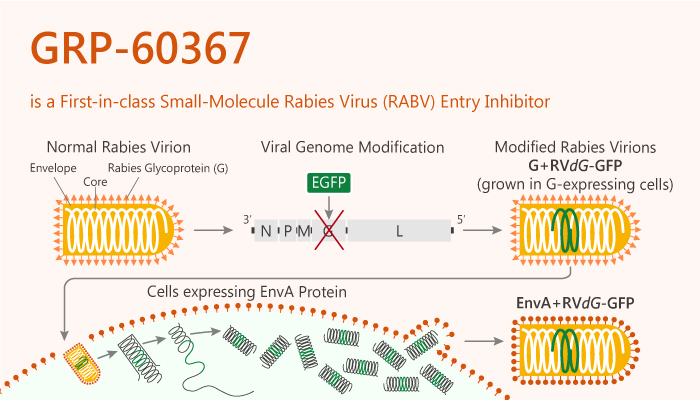Rabies virus (RABV) is an enveloped, nonsegmented, and single-stranded RNA virus. It belongs to the genus Lyssavirus within the family Rhabdoviridae. The virus is the causative agent of rabies, which continues to be a global public health concern that causes approximately 60,000 deaths annually. The spillover of RABV into the human population occurs from a worldwide distribution of animal reservoirs. The majority of cases occur in Asia and Africa. However, immunoglobulin (IgG)-based rabies postexposure prophylaxis (PEP) is expensive, restricting access to life-saving treatment, especially for patients in low-income countries. In this study, GRP-60367 is a first-in-class direct-acting RABV inhibitor, and it inhibits the entry of a subset of RABV strains.

GRP-60367 inhibits the entry of a subset of RABV strains. It shows the specific and potent anti-RABV activity of the scaffold, returning in dose-response assays EC50s ranging from 2 to 52 nM on different host cell lines. GRP-60367 functions as a viral entry inhibitor and argues against compound interference with a host pathway since entry of RABV and VSV follows a common overall strategy. GRP-60367 specifically blocks RABV entry and identifies the RABV G protein as the molecular target of the compound. In a word, GRP-60367 specifically targets the RABV G protein, blocking the entry of some RABV strains with nanomolar potency.
In summary, GRP-60367 is highly potent against the RABV screening virus, returning low-nanomolar EC50s. Furthermore, GRP-60367 shows no cytotoxicity or other morphologically appreciable off-target activities to concentrations of up to 300 μM in counterscreens. GRP-60367 specifically targets the RABV G protein. Thus, it may represent an exciting new molecular probe that will advance further mechanistic and structural characterization of RABV G, aiding in next-generation vaccine and antiviral-drug design.
Reference:
Venice Du Pont, et al.J Virol. 2020 Jun 16;94(13):e00321-20.